And it's goodnight from us Earthlingspublished at 01:32 GMT 28 February 2023
We're closing our live page now.
Thank you to everyone who has sent in magnificent images of the northern lights.
The Met Office says there's a chance that many places across the UK will get to see the northern lights again tonight
It follows a rare display last night which saw the aurora visible as far south as Cornwall
There were also sightings in Northern Ireland, south Wales and Norfolk
However, cloudy skies may limit tonight's view, with the west of Scotland likely to have the best vantage point
An aurora is formed by a solar flare erupting on the Sun, sending charged particles towards Earth which interact with our atmosphere
You can share your photos of the northern lights through the 'Get Involved' button at the top of the page
Edited by Tiffany Wertheimer
We're closing our live page now.
Thank you to everyone who has sent in magnificent images of the northern lights.
You've been sending us some incredible images from across the country of tonight's northern lights.
From pink skies in Lochmaddy in the Outer Hebrides of Scotland to glowing, yellow clouds in Derbyshire, it seems many of you got to enjoy the aurora for the second night in a row.
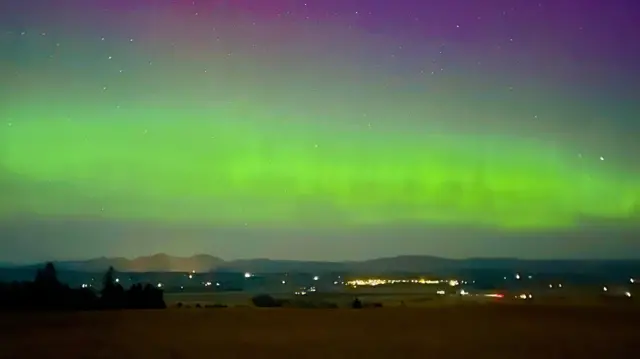 Image source, BBC Weather Watchers/Kate
Image source, BBC Weather Watchers/KateThe glow was seen over Stirling tonight
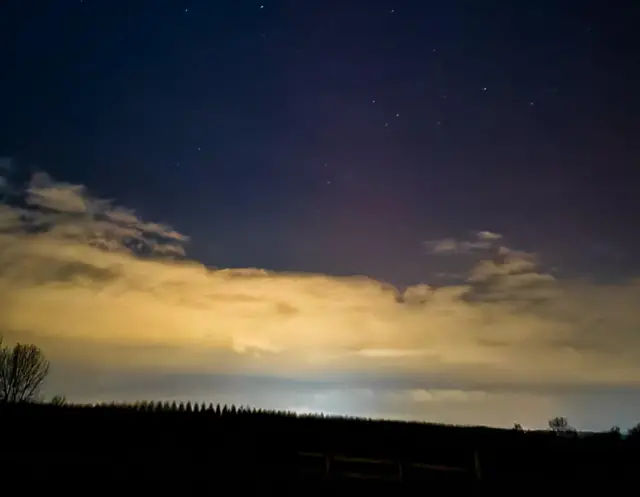 Image source, BBC Weather Watcher, tracey1978tails
Image source, BBC Weather Watcher, tracey1978tailsThis was taken in Overseal, Derbyshire
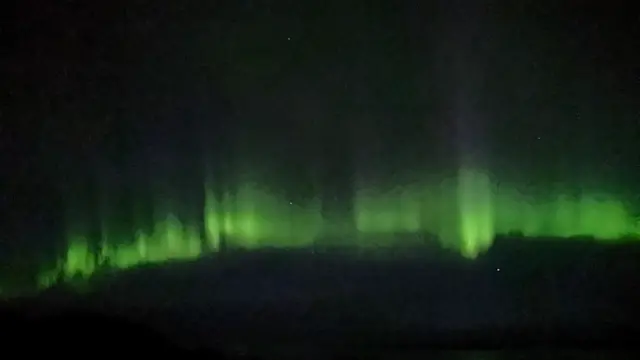 Image source, BBC Weather Watcher, Dappled Dog
Image source, BBC Weather Watcher, Dappled DogAnd this was taken in Drumbeg, Highland
 Image source, BBC Weather Watcher, Skye View
Image source, BBC Weather Watcher, Skye ViewThe dazzling green night sky in Sconser on the Isle of Skye
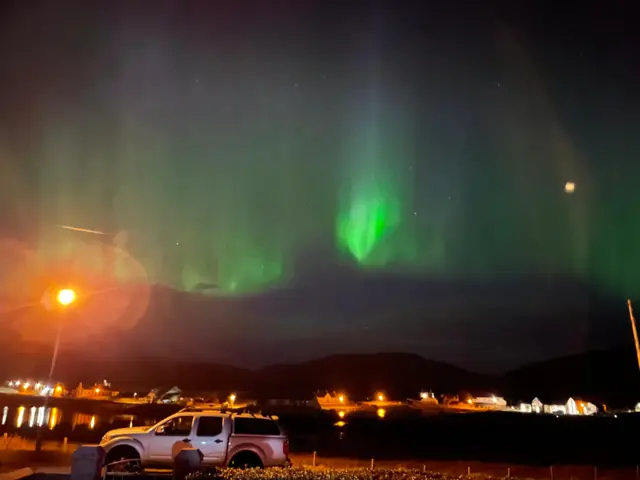 Image source, Weather Watchers/Con in Leverburgh
Image source, Weather Watchers/Con in LeverburghAnd the view from Leverburgh, in the Outer Hebrides
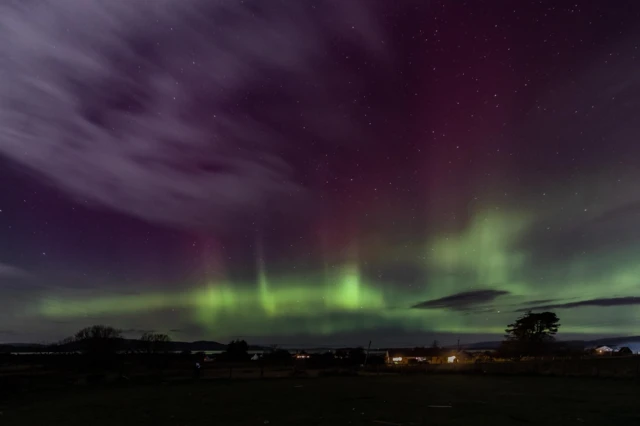 Image source, BBC Weather Watchers, Breakish
Image source, BBC Weather Watchers, BreakishThe Isle of Skye is also providing a spectacular show
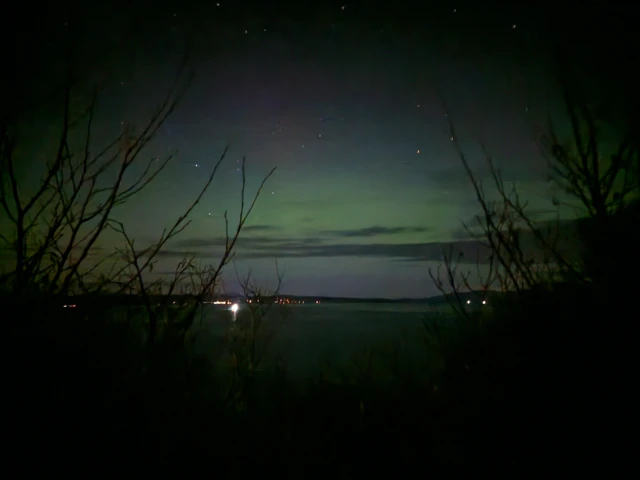 Image source, BBC Weather Watcher, Terrace views
Image source, BBC Weather Watcher, Terrace viewsMallaig has a certain beauty in this light
Our team in BBC Bristol have been sent local photos from Wiltshire and Yate.
You can also send in your pictures of the northern lights tonight by clicking Get Involved at the top of this page or by emailing haveyoursay@bbc.co.uk
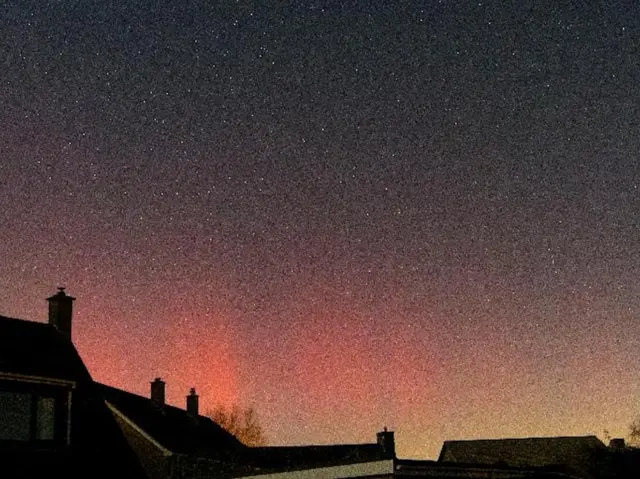 Image source, BBC Weather Watchers, Astro Mike
Image source, BBC Weather Watchers, Astro MikeOur weather watchers captured the view outside their homes
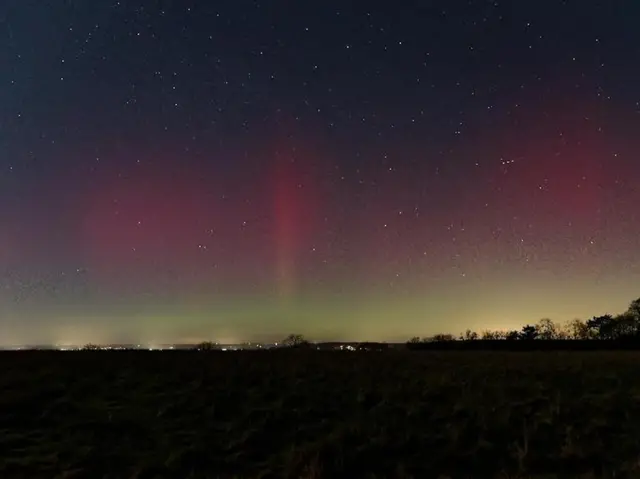 Image source, BBC Weather Watchers, Steve
Image source, BBC Weather Watchers, SteveThe sky appears like a rainbow in some areas
 Image source, BBC Weather Watchers, Elaine C
Image source, BBC Weather Watchers, Elaine CPhotographs have been sent from Wiltshire and Yate
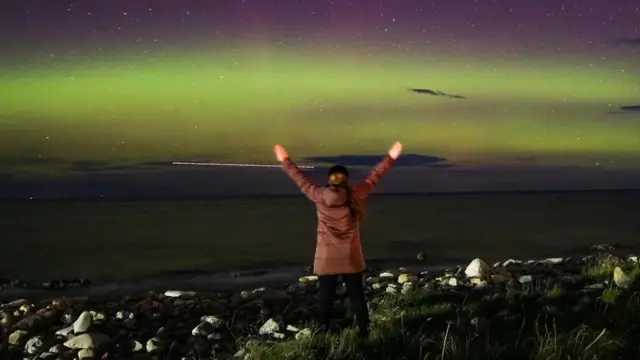 Image source, Michelle Cumming
Image source, Michelle CummingMichelle Cumming enjoying a display of the aurora with the lights of an RAF jet streaking across the sky
Some people are prepared to stand for hours in the freezing cold on a winter's night to watch and capture the northern lights.
Meet the aurora hunters.
Michelle Cumming has been fascinated with the northern lights since she saw the phenomenon for the first time in September 2020.
"I've made last minute dashes in my unicorn PJs," says the 42-year-old, who lives in Moray on Scotland's north-east coast.
"And I've had my backpack and flask prepared to go aurora hunting. I often take my dog Dexter with me, wrapping him up in a fleece blanket while we stand and watch the aurora."
 Image source, BBC Weather Watchers, PhotographerDan
Image source, BBC Weather Watchers, PhotographerDanLovely purple hues painted the night sky in Poringland, Norfolk
BBC Weather Watcher Photographer Dan took this stunning photo in Poringland, Norfolk this evening.
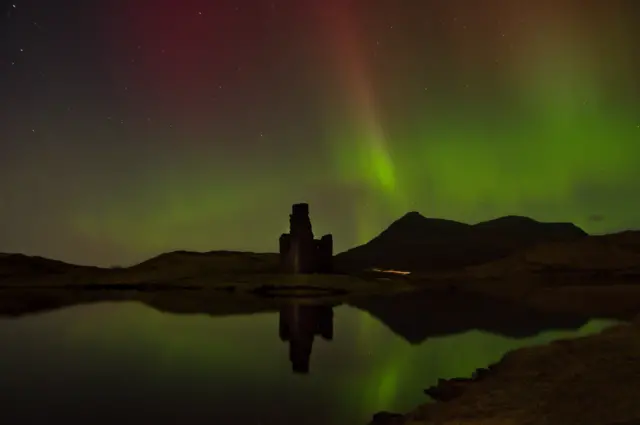 Image source, BBC Weather Watchers, Dave
Image source, BBC Weather Watchers, DaveLochinver Castle
This spooky picture of a castle is in Lochinver in the Scottish Highlands and was taken by BBC Weather Watcher Dave.
Morgan Spence
BBC Scotland
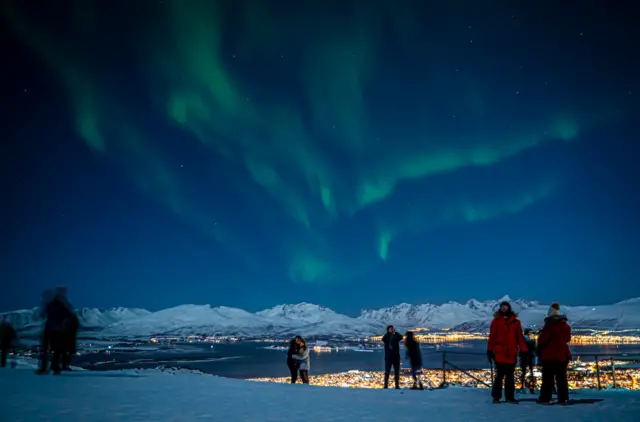 Image source, Morgan Spence BBC News
Image source, Morgan Spence BBC NewsThe Aurora Borealis over Tromsø, Norway back in January: Shutter speed of two seconds, ISO 1000, f/2.8 aperture
There are a few key settings to help get the most out of your camera when photographing the northern lights, as I found out on a recent trip to Tromsø in Norway.
Even though smartphones can capture the phenomenon, a DSLR camera will give you the best results.
Many northern lights seekers worry that a full moon will prevent the display being as bright.
Tonight's moon reflects the green colours coming through the auroral display.
Often northern lights photographers like the presence of a full moon as it adds another interesting view to their aurora pictures.
Tonight we've had weather watchers capture the first quarter moon in Suffolk.
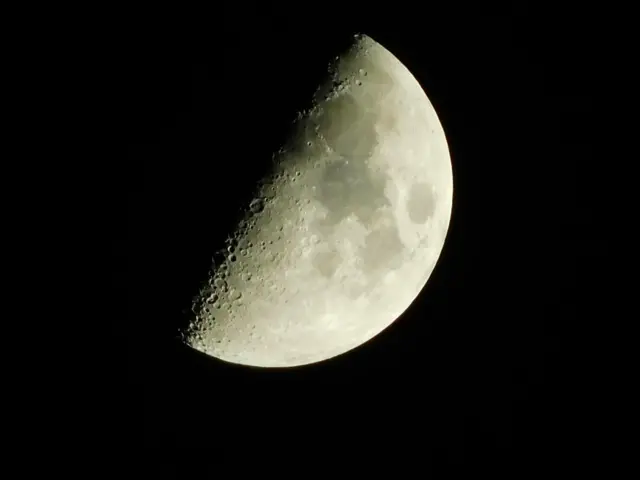 Image source, BBC Weather Watcher, Gone Clicking
Image source, BBC Weather Watcher, Gone ClickingThe quarter moon in Beccles, Suffolk
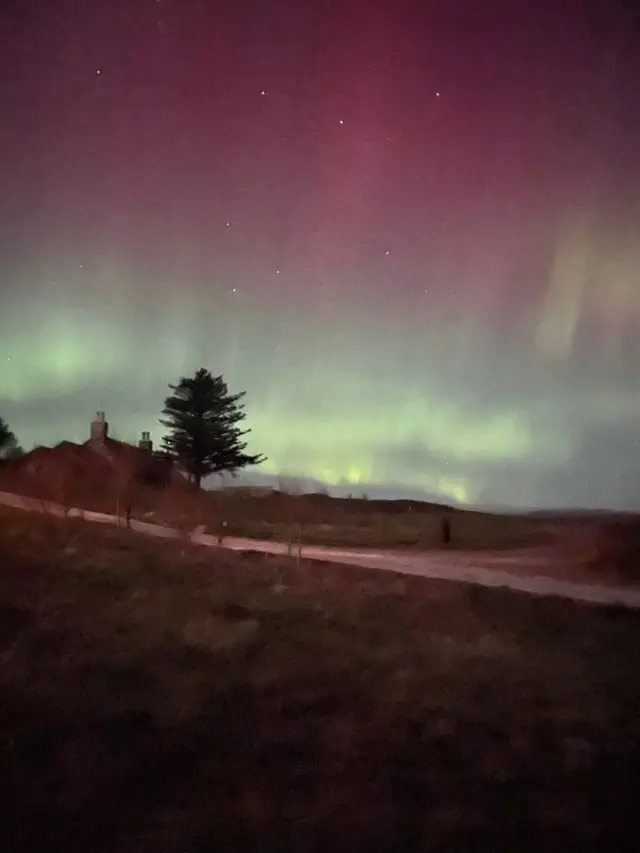 Image source, Hugo McCarthy
Image source, Hugo McCarthyHere's the view from Tanera Mor, one of the summer isles off the Scottish coast
Hugo McCarthy took this picture on a small island off the west coast of Scotland called Tanera Mor.
Hugo says: "I’d just like to say how magical and mesmerising the spectacle was and how you can see how people used to think that gods used to live up in the sky."
 Victoria Gill
Victoria Gill
Science correspondent
 Image source, Sharon Chambers
Image source, Sharon ChambersThere was a dazzling light show in Elgin last night
A Finnish legend has it that the northern lights are sparks from the tail of an Arctic fox as it dashes across the sky.
There is a Norse myth that they are reflections from the shields of the Valkyries - female spirit warriors that transported fallen soldiers to the land of the Gods.
But the science of this shimmering display - that is particularly intense at the moment - is just as other-worldly.
It is caused by the solar wind, charged particles that stream away from our Sun at speeds of about one million miles per hour, interacting with our planet’s magnetic field.
This solar wind has its own magnetic field that can merge with the Earth's magnetic field lines and connect our planet to the solar wind.
It is this connection that can energise charged particles, firing them towards the Earth where they collide with the atmosphere and cause this glow.
A particularly explosive outburst from the Sun, known as a coronal mass ejection, essentially drags Earth’s magnetic field lines even further away from the poles – making the northern lights visible further south.
For some people, tonight is just as exciting as last night.
You can never get too much of the aurora borealis.
Allow X content?
This article contains content provided by X. We ask for your permission before anything is loaded, as they may be using cookies and other technologies. You may want to read X’s cookie policy, external and privacy policy, external before accepting. To view this content choose ‘accept and continue’.
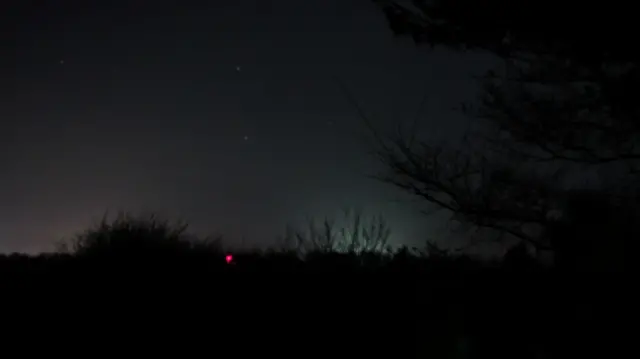 Image source, Lauren Hyde
Image source, Lauren HydeShotley Gate in Ipswich, Suffolk is more subtle in its illumination
Cloud cover means some areas will unfortunately miss out on a second night of the rare light phenomenon.
But Lauren Hyde, who took this picture from her back garden in Shotley Gate in Ipswich was content with just a glimmer of green in the distance.
“My dream has come true!” she said.
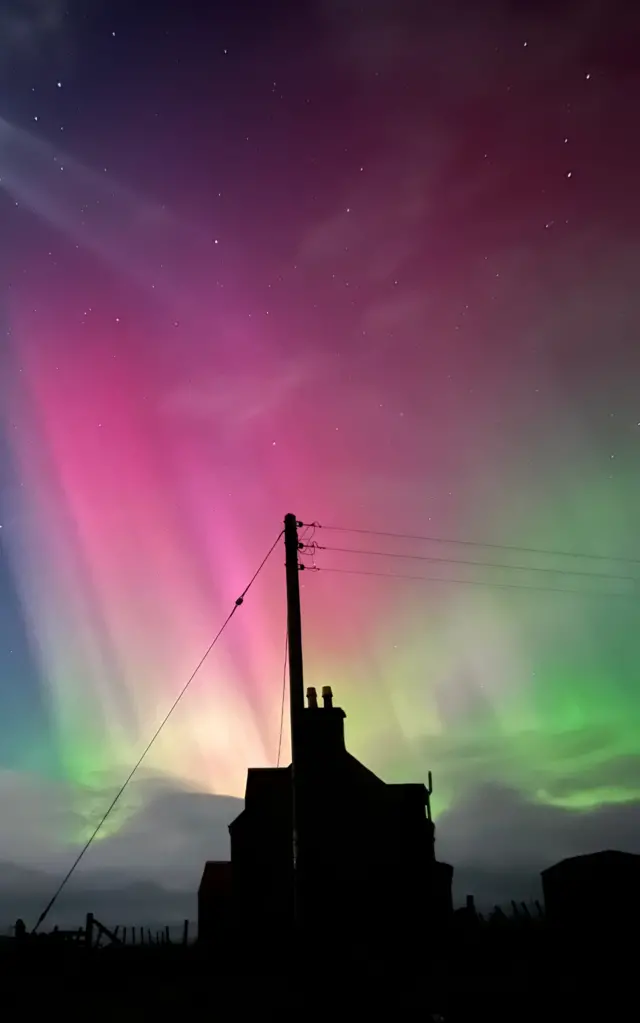 Image source, Lucy MacAskill
Image source, Lucy MacAskillThe Isle of Berneray is providing a beautiful vista this evening
This picture was captured by Lucy MacAskill on the Isle of Berneray in Scotland's Outer Hebrides who says: "The northern lights never normally appear as bright where we live.
"One of the best locations to view from in the Scottish Isles."
 Pallab Ghosh
Pallab Ghosh
Science correspondent
Nine out of ten times when there is an aurora, it appears as a lovely green ethereal glow.
This time though the sky is also filled with reds and purples as well.
That is because the strength of the solar storm is activating the atmosphere higher up, which has proportionately more nitrogen.
This emits blue and red lights when energised. The more oxygen-rich atmosphere lower down emits the green.
The colours also appear more intense than usual because the Moon is only 50% visible and the air has been unusually clear.
Scientists are expecting there to be more such events over the coming months and years as the Sun approaches its active cycle.
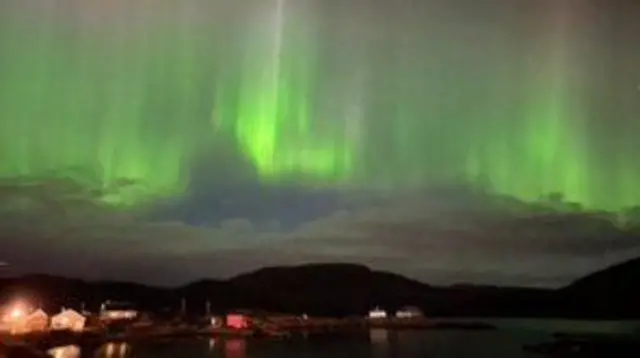 Image source, BBC Weather Watchers/Artymum
Image source, BBC Weather Watchers/ArtymumThis is the view over the Western Isles tonight
 Image source, BBC Weather Watchers/Bobby
Image source, BBC Weather Watchers/BobbyLochmaddy is seeing the colours bright tonight
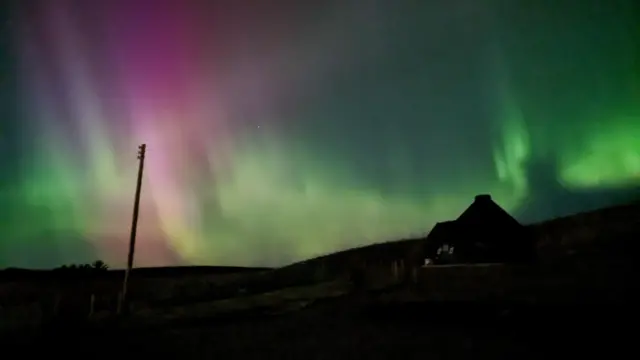 Image source, BBC Weather Watchers/Dean
Image source, BBC Weather Watchers/DeanBeautiful shades of green and red are also in the sky above Carloway, in the Isle of Lewis in the Outer Hebrides
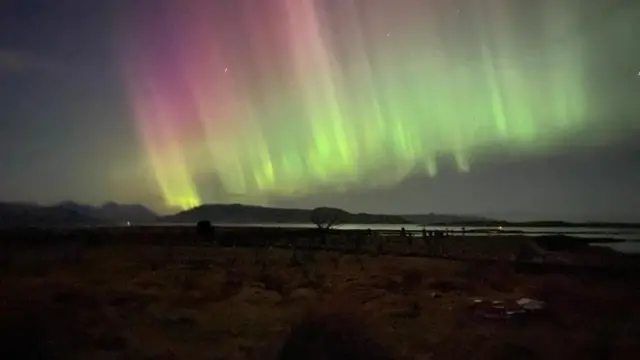 Image source, BBC Weather Watchers/Jackie MacLennan
Image source, BBC Weather Watchers/Jackie MacLennanResidents of the Isle of Skye have been treated to displays of the aurora already tonight - Jackie MacLennan captured these images of the island's light show.
Frustratingly, cloud has obscured the view of the night sky for large parts of the Highlands that enjoyed views of the aurora on Sunday.
 Image source, BBC Weather Watchers/Jackie MacLennan
Image source, BBC Weather Watchers/Jackie MacLennan Simon King
Simon King
BBC weather presenter and meteorologist
With activity on the Sun’s surface remaining high, we’re likely to see the northern lights again tonight.
The current forecast is for a geomagnetic storm with planetary index (Kp) 7 – a measure of the magnitude of a geomagnetic storm.
Kp 7 would mean the aurora could be visible as far south as southern England, just like we had last night.
You will need clear skies and a good view of the northern horizon away from any light pollution.
While the northern lights can be visible with the naked eye during intense solar storms, to really see the full effect then you would need to view through a camera.
Cameras are able to detect the colours of an aurora better than our human eye and when used with long exposures, colours will become more vibrant.
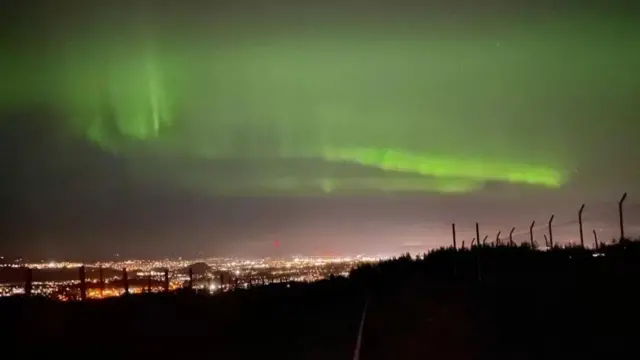 Image source, Ella McKenzie
Image source, Ella McKenzieSteven McKenzie and his daughter Ella raced to the top of a local hill above Inverness to get the best view
BBC Scotland reporter Steven McKenzie hurried to find the best vantage point during last night's dazzling display.
"My eldest daughter Ella and I headed up a hill to see them above Inverness. The northern lights were amazing last night," he said.
And it seems he wasn't the only one. Here's hoping the sky shines as bright for tonight's stargazers!
 Image source, BBC Weather Watchers/Bluecat
Image source, BBC Weather Watchers/BluecatBBC Weather Watcher Bluecat captured this view of the spectacle over Dunfermline
 Image source, BBC Weather Watchers/Kev B
Image source, BBC Weather Watchers/Kev BVibrant green colours of the aurora filled the whole sky in the Shetland Islands
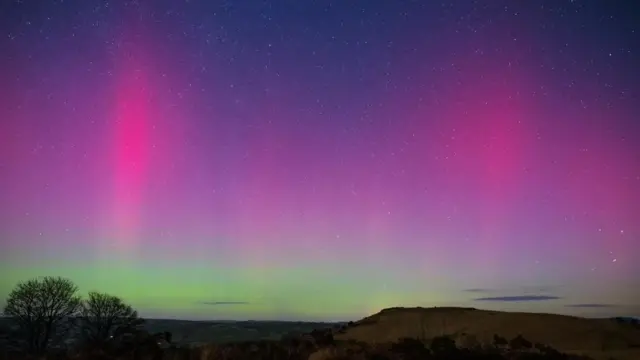 Image source, BBC Weather Watchers/Karl McCarthy
Image source, BBC Weather Watchers/Karl McCarthyA kaleidoscope of colours was cast over the Brecon Beacons in south Wales
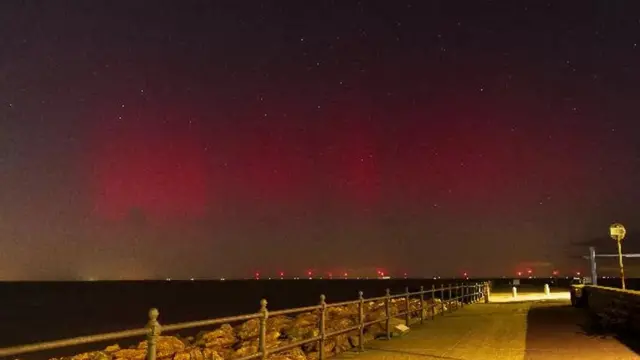 Image source, BBC Weather Watchers/Jamie
Image source, BBC Weather Watchers/JamieThe lights are rarely seen in Kent, southern England